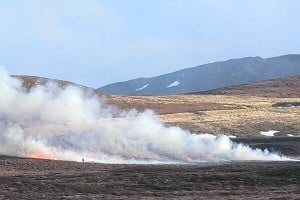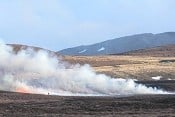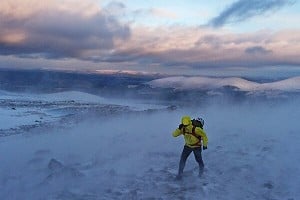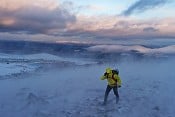
Last week the Scottish Parliament yet again failed to stop the unregulated spread of vehicle tracks in our hills. The new Planning Bill offered a golden opportunity to get a grip on the damage being caused to some of Scotland's best-loved uplands, thanks to progressive amendments put forward by Scottish Green MSP Andy Wightman.
He won the support of Green, Labour and Liberal Democrat colleagues, but SNP and Conservative MSPs joined forces to vote against the changes.
Mr Wightman made great efforts to explain the issues, based on evidence brought by a coalition of 10 environmental and recreation bodies working together as Scottish Environment LINK.
While ordinary people need to apply for planning permission to build modest extensions to their houses, tracks are being bulldozed up mountainsides causing permanent scars with no public oversight
The result means that landowners can continue to exploit a post-war planning loophole to create these 'hilltracks', which are often built to make it easier to stalk deer and shoot grouse.
The amendments wouldn't have banned hilltracks. They wouldn't have stopped people shooting in our hills. They would have simply required landowners to get planning permission – just as is required for new recreational paths, such as the Speyside Way.
The response
The result will have frustrated more than 800 people who wrote to MSPs using LINK's online form hosted by Ramblers Scotland, and almost 2,000 who pledged support on the Scottish Green Party's website.
It has also saddened many prominent outdoor personalities. Broadcaster Cameron McNeish branded it "absolutely bloody shameful", author Muriel Gray said it was "baffling", long-distance walker Chris Townsend said it was "disgraceful" and world-class climber Dave MacLeod described the Government as "short-sighted and disappointing."
Climbing journalist Ed Douglas said it was: "Bizarre, given the immense reputation the Scottish landscape enjoys around the world, that you would trash it so a few people too lazy to walk can shoot birds."
Snow expert Iain Cameron summed up the feelings of many when he asked: "Can anyone give even one good reason why monstrosities like these are allowed to be constructed without any oversight or scrutiny? I'm speechless."
What has created the hilltracks free-for-all?
Tracks built for 'agricultural or forestry' purposes benefit from 'permitted development rights' (PDRs), a situation dating back to post-WW2, when there was a desperate need to boost productivity after years of hardship. Since then, many landowners have taken advantage of this planning loophole to build tracks that are in reality there to make it easier for people to shoot grouse and stalk deer.
Landowners have been able to claim 'agricultural' use for the tracks as it near-impossible for planning authorities to prove otherwise, even when the track leads to a row of grouse butts.
Decades of campaigning
Concerns were first raised about hilltracks in the 1960s when Lord Dulverton bulldozed a track from Glen Feshie right to the top of the Cairngorm plateau. The late Dr Adam Watson documented the proliferation of tracks in the Cairngorms over the following years, and many outdoor and environmental bodies have attempted to tackle the issue.
In 2012 a government review found "compelling evidence" to support a change in the law – but the then Planning Minister Derek Mackay, suddenly announced that he had changed his mind. A slight tweak of the law in 2014 made landowners give 'prior notification' before building tracks, but it's still very difficult for planning authorities to stop tracks being built. Unsurprisingly, this has delivered few meaningful changes.
The LINK Hilltracks group continues to collect evidence on problem tracks from the Borders to Sutherland, including particularly horrendous examples in the Pentland Hills and within the Cairngorms National Park.
Tracks built as part of run-of-the-river hydro schemes do require planning consent, but all too often we're learning about tracks which are poorly constructed or not properly restored afterwards. We're monitoring such tracks to gather evidence of the scale of the problem. Find out more about that here.
Why do we need stronger laws?
Environmental damage: We're seeing vehicles tracks that cause permanent scarring to landscapes, including SSSIs, rare habitats and important peatland environments.
Industrialising the countryside: Tracks are creeping further and further into Scotland's wilder areas, industrialising special environments and impacting on people's outdoor experience. This includes vehicle tracks bulldozed near the summits of popular Munros.
Bad build quality: Due to the lack of oversight, construction standards are often poor. This results in 'rubble' tracks that wash away during heavy rain, deep banks that are too step to re-vegetate and inappropriate materials including visible plastic piping.
Democratic deficit: Perhaps the biggest issues is fairness. These tracks symbolise the abuse of privilege by many landowners. While ordinary people need to apply for planning permission to build modest extensions to their houses, tracks are being bulldozed up mountainsides causing permanent scars with no public oversight.
Tracks can have several uses, and we completely acknowledge that some can be useful for mountain-biking and walking – although sadly many have been built over the top of existing narrow, low-impact trails, including historical routes.
However, the current system offers no opportunity for the public to weigh up the pros and cons of potential new tracks.

What next?
During last week's debate, Planning Minister Kevin Stewart promised to consider hilltracks again during a major review of 'permitted development rights', which is likely to happen next year. We are determined to hold him to that commitment – and to continue building the case for change.
You can help keep the issue in the spotlight, by sharing #hilltracks photos on social media, emailing [email protected] or by discussing the issue with politicians, planning authorities and your fellow outdoor enthusiasts. For more info see ramblers.org.uk/hilltracks
I still firmly believe that together we will save our landscapes from the ongoing free-for-all spread of hilltracks.
The campaign goes on.
Helen Todd is campaigns & policy manager with Ramblers Scotland and co-convener of the LINK hilltracks group.
Members of the LINK group are: Association for the Protection of Rural Scotland, Badenoch & Strathspey Conservation Group, Cairngorms Campaign, John Muir Trust, National Trust for Scotland, North East Mountain Trust, Ramblers Scotland, RSPB Scotland, Scottish Campaign for National Parks and Scottish Wild Land Group.
Mountaineering Scotland, while not a member of LINK, also supports this campaign.

















Comments
Hi, (I work for Ramblers Scotland) I'm afraid the letter-writing form is no longer live as the vote has taken place. (I've popped UKH an email to update the story when they get a minute.)
Sadly it's likely to be quite a while until the issue is discussed at Holyrood again. Fingers crossed hilltracks can finally be resolved at the Permitted Development Review which is set to take place next year. We'll make sure to raise the profile of the issue again ahead of that review - and to provide more opportunities for everyone to contact decision-makers, at the most relevant and impactful moment. This time around, more than 800 people used our form to write to MSPs. I gather that around 2,000 people got involved with the Scottish Greens' petition on the issue too. It's seriously disappointing that the Scottish Government ignored those pleas and once again passed up the opportunity to change the law. There are such obvious arguments for change on landscape, environment and fairness grounds that the SNP and Conservative position during last week's vote was pretty baffling. For anyone wishing to really geek out on the hilltracks issue, I'd strongly recommend a read of the Scottish Environment LINK Changing Tracks report from last year: http://www.scotlink.org/wp/files/Changing-Tracks_LINK_Hilltracks_Report.pdf
Thanks for all who've supported the hilltracks campaign in recent months and years. Danny Carden
Thanks for raising awareness. I'll send them some photos of the 2 new quarries that have appeared on the local grouse moor to support the construction of a new #hilltrack and resurfacing of the ones they bulldozed last year that have barely lasted despite one of the driest periods I've ever seen.
Thanks for the update Danny
I've seen much commentary such as this but no explanation as to why the Scottish SNH Government voted it down...I can understand why the Scottish tories did but not SNP.
Anyone shed any light. Is it just because of the review next year?
Leaves plenty of time to get those last minute tracks put in!
My personal view as to why the SNP MSPs voted it down:
It is not mainly because of the impending review of Permitted Development Rights. The review does, however, present another opportunity, although suggesting it is more appropriately dealt with there can been seen as kicking the can down the road.
It is rumoured that a number of SNP back benchers were sympathetic to Andy Wightman's proposed amendments to the Bill but the SNP exercises very strict party discipline and their backbenchers almost never step out of line. Whether you think this is a good thing or not is a separate matter. Those who wrote to SNP MSPs received very similar responses which reflects the central control being exercised on the matter.
The SNP considers that robust legal control of tracks have could have economic disadvantages. Any such disadvantages are negligible to the point of being irrelevant but the SNP's case for independence hinges on the economic arguments, so there is resistance to any changes which could conceivably be interpreted as having econmic impacts.
What would be particularly helpful would be if people, who are concerned that the current controls on tracks are inadequate and who are SNP members or are regularly in touch with SNP MSPs, ask SNP MSPs to press the case for change with the relevant Ministers.